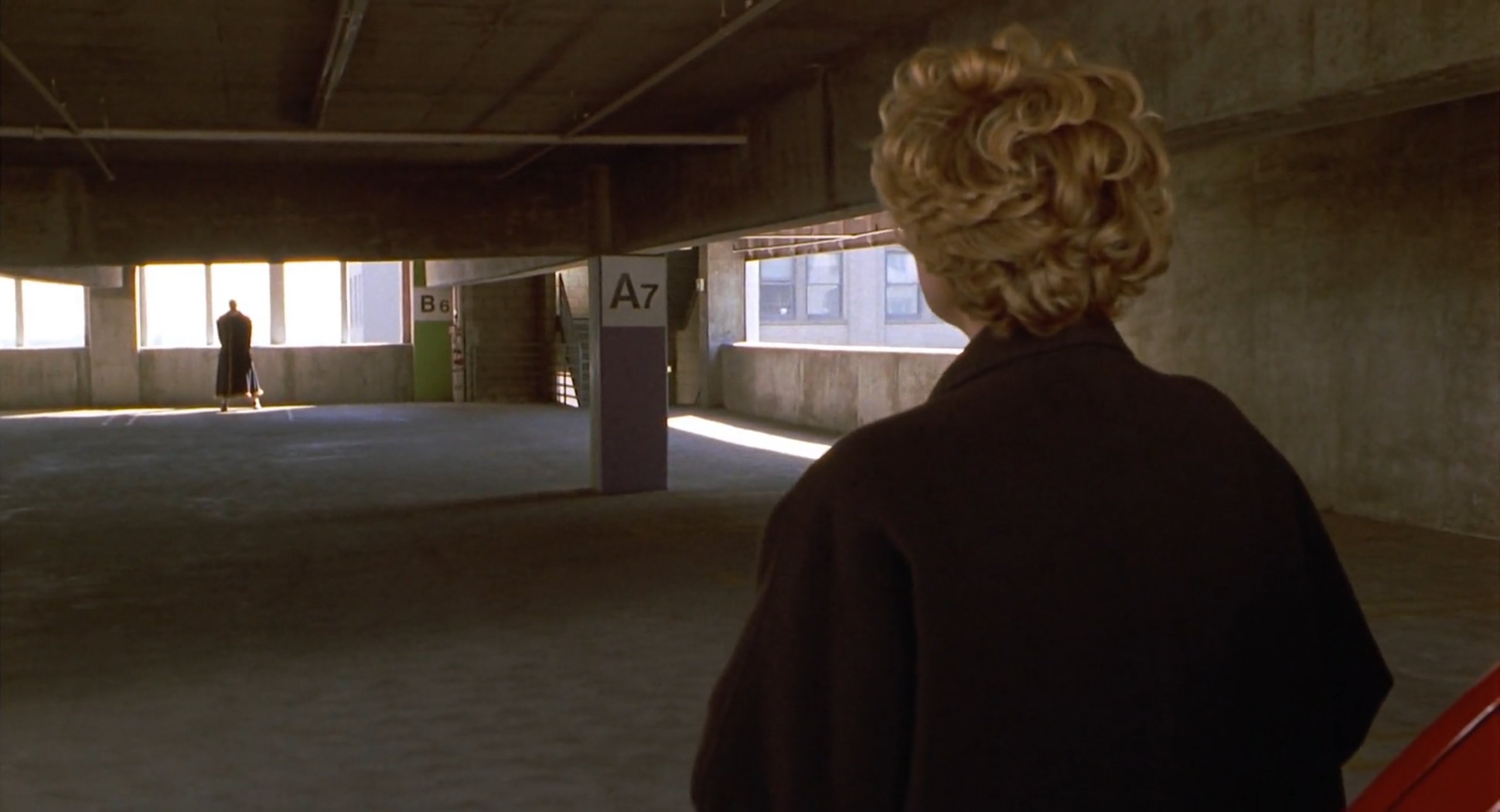 Candyman (1992) 00:44:33
December 15, 2020
Candyman (1992) 00:44:33
December 15, 2020
Monsters and Feminism: Women, Difference, and Horror in Bernard Rose's Candyman (1992)
Candyman (dir. Bernard Rose, 1992) is a Hollywood studio horror film featuring excellent performances by Helen Lyle (Virginia Madsen) and the villain-monster Candyman (Tony Todd). In this essay, I argue that Candyman uses close-ups and elements of the mise-en-scene to both empower and punish the white woman protagonist, Helen, while contrasting her to the other figures and forces in the film. I will begin with a summary about horror plots from Noel Carroll and then proceed with a summary of the film’s plot leading up to the two scenes I will analyze.
In Noel Carroll’s essay “Why Horror”, one of her main arguments is that “art-horror is the price we are willing to pay for the revelation of that which is impossible and unknown, of that which violates out conceptual schema. The impossible being [the monster], does disgust; but that disgust is part of an overall narrative address…”, concluding that horror’s pleasure depends on this being violating, rebuking, or complicating “standing cultural classifications.” (Carroll) Carroll argues that typically in horror film the narrative involves discovering, investigating, and interacting with a monster of some sort, such as in the plot of Candyman, Helen researches, pursues, and ultimately confronts Candyman. However, the “standing cultural classifications” serve as fuel to the horror tension as much as the monster does across the film, reflecting as a mirror back at the audience. The way Helen is not believed and judged by her community, while at the behest of the situations Candyman sets her up for, makes these patriarchal forces, at times, as much a threat to her safety as Candyman. Helen is originally assaulted not by the “monster”, but by her outside world serving as the monster. She is attacked by the gang members for investigating in their territory, arrested by the police, and abandoned by her husband after not being harmed by Candyman, but by being framed by him. Candyman is canonically created by past cultural norms that allowed a black man to be lynched for merely acting human and with autonomy in his community, to a lesser extent Helen shares a similar persecution for being the woman who looks and searches in the Chicago suburbs in the early 90s.
 Candyman (1992) 00:07:59
Candyman (1992) 00:07:59
Helen is a somewhat privileged white graduate student at the University of Chicago working on a research project concerning local myths and legends. There is a legend in her area that if you say Candyman five times in a mirror, Candyman will come for you. A black coworker, Henrietta Mosely (Barbara Alston), overhears her while she is cleaning and directs her to a site called Cabrini Green, where she discovers similarities between Cabrini and her own apartment complex building. Helen learns about the history of the legend from a professor, that Candyman was a somewhat wealthy educated black man in the 1890s who was lynched for falling in love with a wealthy, white, land-owners daughter. They cut his hand off and burned him alive, then scattered his ashes where Cabrini Green is now built.
Helen returns to Cabrini Green with Bernadette Walsh (Kasi Lemmons), a black graduate peer of hers helping with the project. Helen climbs through the window in the apartment of the crime scene Henrietta directed her to and starts to believe the myth has a less-than fantastic explanation of just being some crime related murders. The five shots in this scene of Helen climbing through a hole in the wall and observing the mural of Candyman at 00:23:33-00:24:17 will be the first scene I analyze. This segment of the film highlights the difference between our white protagonist compared to her black peer Bernadette, her audacity to access forbidden spaces, and is a metaphor for the cultural comments the film makes.
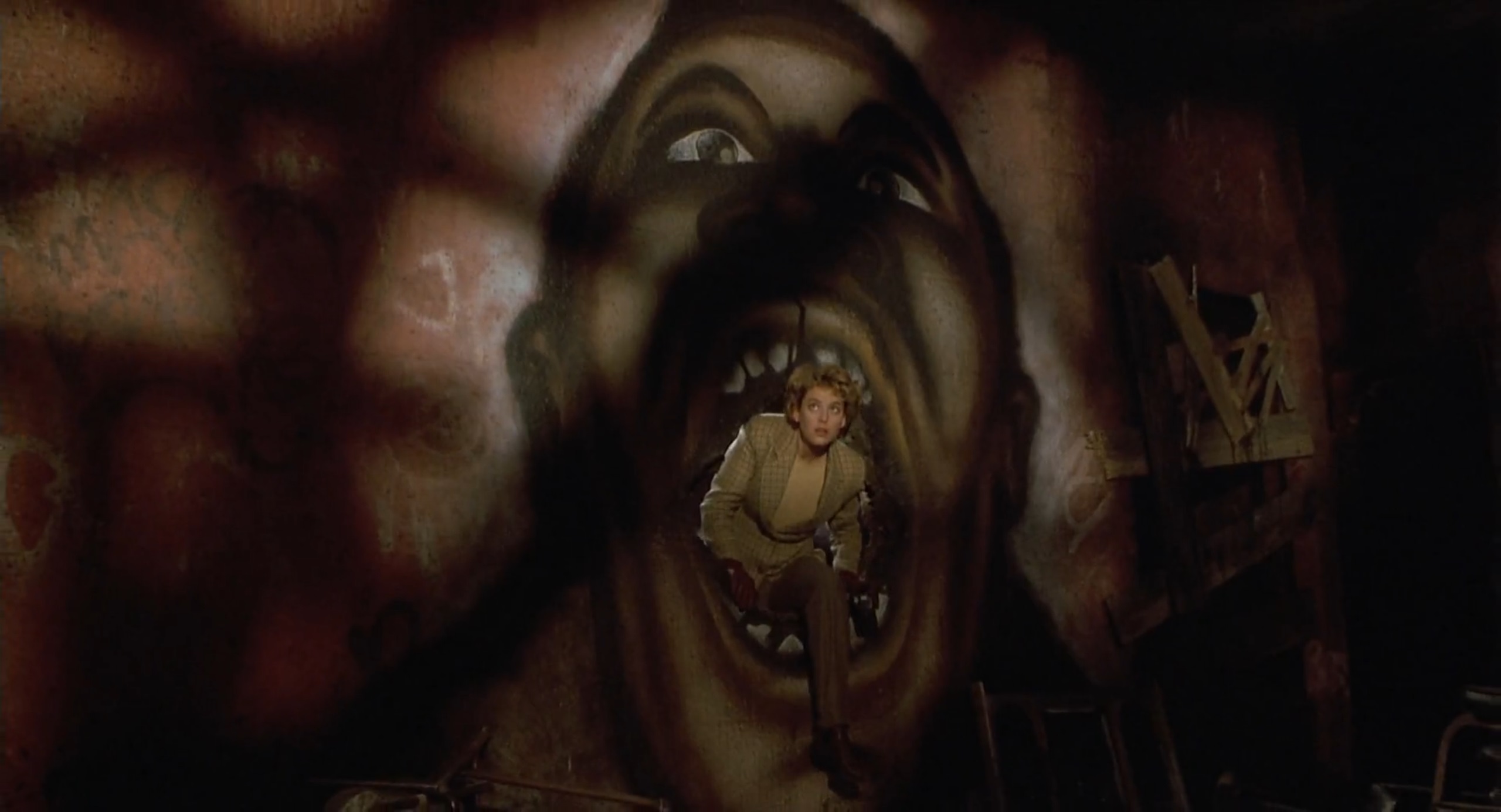 Candyman (1992) 00:23:52
Candyman (1992) 00:23:52
The first shot of this scene, in the abandoned apartment behind the mirror, begins with a top angle tracking shot of Helen taking pictures for her research. The camera mirrors her movement at first and then backs away as she approaches a hole in the wall leading to another room. As Helen leans into the opening, the camera positions itself behind a crumbling structure, blocking half of the opening from view. Shot two begins facing Helen in the other room as a medium shot but expands to a long shot, beginning with Helen taking a picture in the direction of the camera through the opening. The frame of the start of this shot encases Helen in the teeth of the mural of Candyman in the abandoned apartment. This frame at 0:23:45 is a metaphor for the danger Helen is walking into while distracted by her own goals. The shot continues as Helen’s camera stops working, and “our” camera zooms out into a long shot as she climbs into the room and observes along side us the mural of Candyman over the hole to the next room. By Helen having a camera in this scene and with her following the camera’s gaze in these two shots, this scene can be used to understand the cultural context and message of Candyman. Across the film Helen faces danger from the spectral monster Candyman and is terrorized by him, but she also leads herself into his grasp by pursuing his legend. Both her and Bernadette say Candyman five times in the mirror, but Helen is the one who goes into the mirror in Cabrini Green. Yet Candyman punished Bernadette with death while bargaining and luring the white protagonist. Helen ultimately still faces danger from the gang community near Cabrini, the legal system that refuses to believe her side of the story, and from a cheating a husband who turns her in. Helen not only faces a monster in Candyman, she faces the same monsters of culture and oppression that once condemned Candyman himself to his own demise.
The ground in shot two is littered with overturned chairs and other pieces of furniture, and there is a large hole in the wall to the right of the mural that is shoddily boarded up. Light comes through some obstructed source into this second room, and the shadows make an upside-down pentagram to the left of the mural on the wall. Shot three is a close up shot of Helen from a side angle profile shot, the low-key lighting in this shot leaves the front of Helen’s face draped with shadows. Shot four straight cuts to a close up where the entire frame shows only the eyes of the Candyman mural in a perspective shot from Helen’s vantage point. The frame is split diagonally by a dark shadow interrupting the light source, reminisce of the way the hook of Candyman slices across his victims. The camera straight cuts to shot five, a bit further back than shot three in a medium-close shot of Helen. She is still entranced by the eyes of the mural, again mirroring the camera’s previous vision with her own, establishing the metaphorical implications the film presents by endangering the white female protagonist with a society that oppresses and disbelieves her. The theme music of Candyman, the eerie chorus of voices and organ piano which has been building in this scene reaches its climax during this moment, as a woosh is heard over shot four. Shots four and five, the most vital shots in this scene, demonstrate the link being established between the lynched black Candyman with the white wealthy woman. Helen steps forward with one foot and refocuses her vision as she rubs her eyes with her left hand. She blinks a few times, is able to snap out of it, and notices something on the floor below her. At the end of shot five, Helen kneels and goes out of frame.
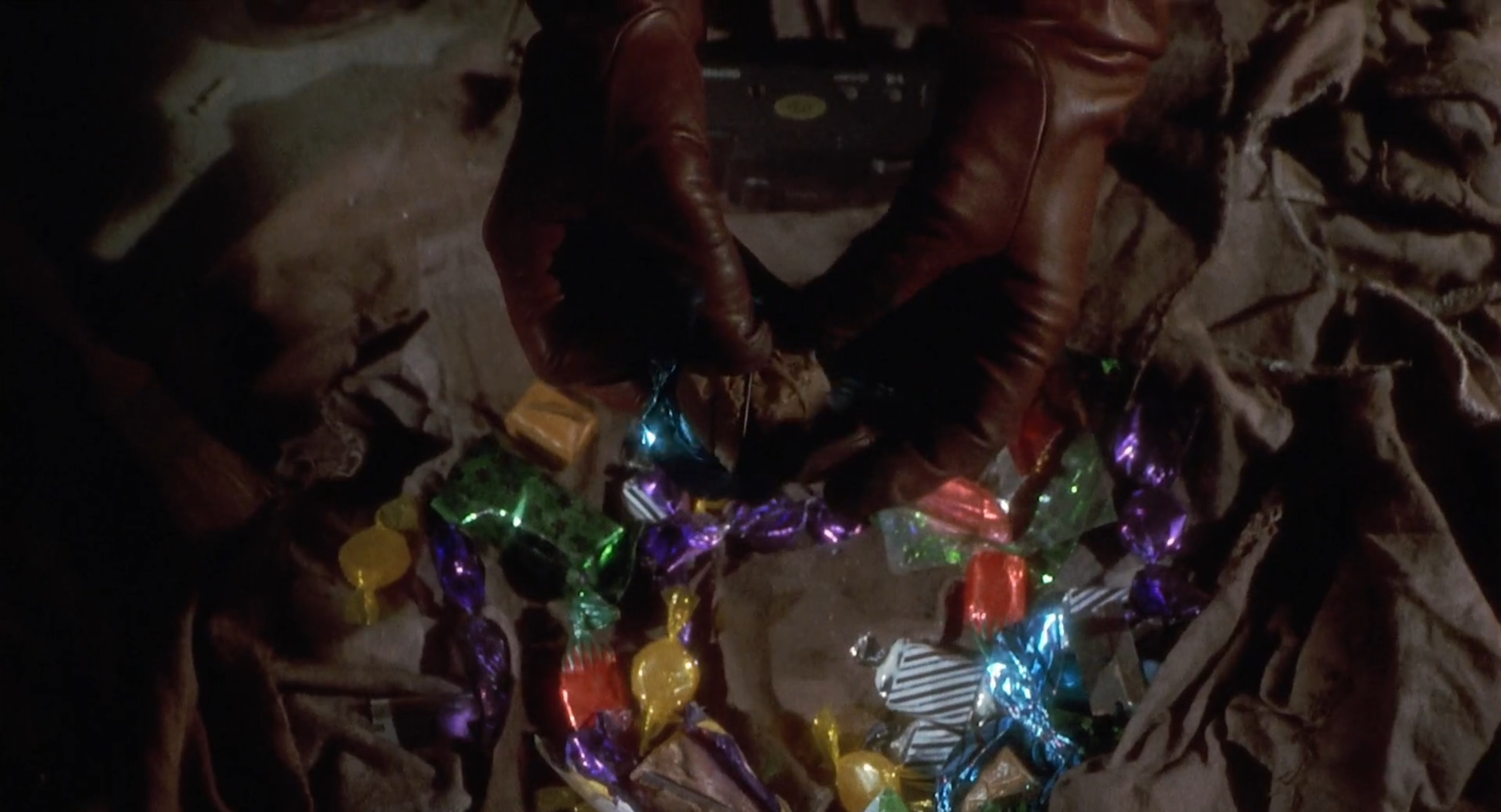 Candyman (1992) 00:24:25
Candyman (1992) 00:24:25
Helen discovers some candy wrappers in the apartment, making her think the recent murder there might just be gang activity. She continues to pursue this lead in Cabrini and gets a lead at a local park bathroom where she is assaulted by a local gang leader who himself is playing into the legend. Just as starts to feel confident she has cracked the case of the recent murders actually being a result of some petty or gang related crime, Helen meets the authentic, supernatural Candyman in a parking garage. Helen goes unconscious and wakes up back in Cabrini, covered in blood from a dog in an apartment with a rightfully hysterical mother and a missing child. She is charged with several crimes, but is able to post bail. While in her apartment Candyman again appears to her, saying he will take her and spare the missing child, but her friend Bernadette accidentally arrives before the deal can be made is slain by Candyman. Trevor Lyle (Xander Berkeley), Helen’s white husband, discovers Helen paralyzed in fear with her dead friend, and directs the police to the crime scene. Here again the plot mimics and “mirrors” the cultural norms of the society Candyman takes place in and was written in, while the white woman gets a mock trial and investigation at least, the black woman is killed, like Candyman, without much ceremony.
This brings us to the segment of my second scene for analysis that occurs at 01:06:49-01:12:00. Helen has been held in a psychiatric hospital for an unknown period, less than a week most likely, and has been led to a therapist’s office. It is in this scene, the twelve shots from 01:10:00 to 01:11:02 specifically, where Helen bound in a psychiatric hospital, chooses to look into a mirror and utter the forbidden. The event of Helen’s look becomes a metaphor of the power dynamic interaction between woman and authority in the 90s. The metaphor underlines a woman’s own existence in and the punishment they receive for such a disruption of the patriarchy, as well as their shared perception with societies “monsters” (Williams).
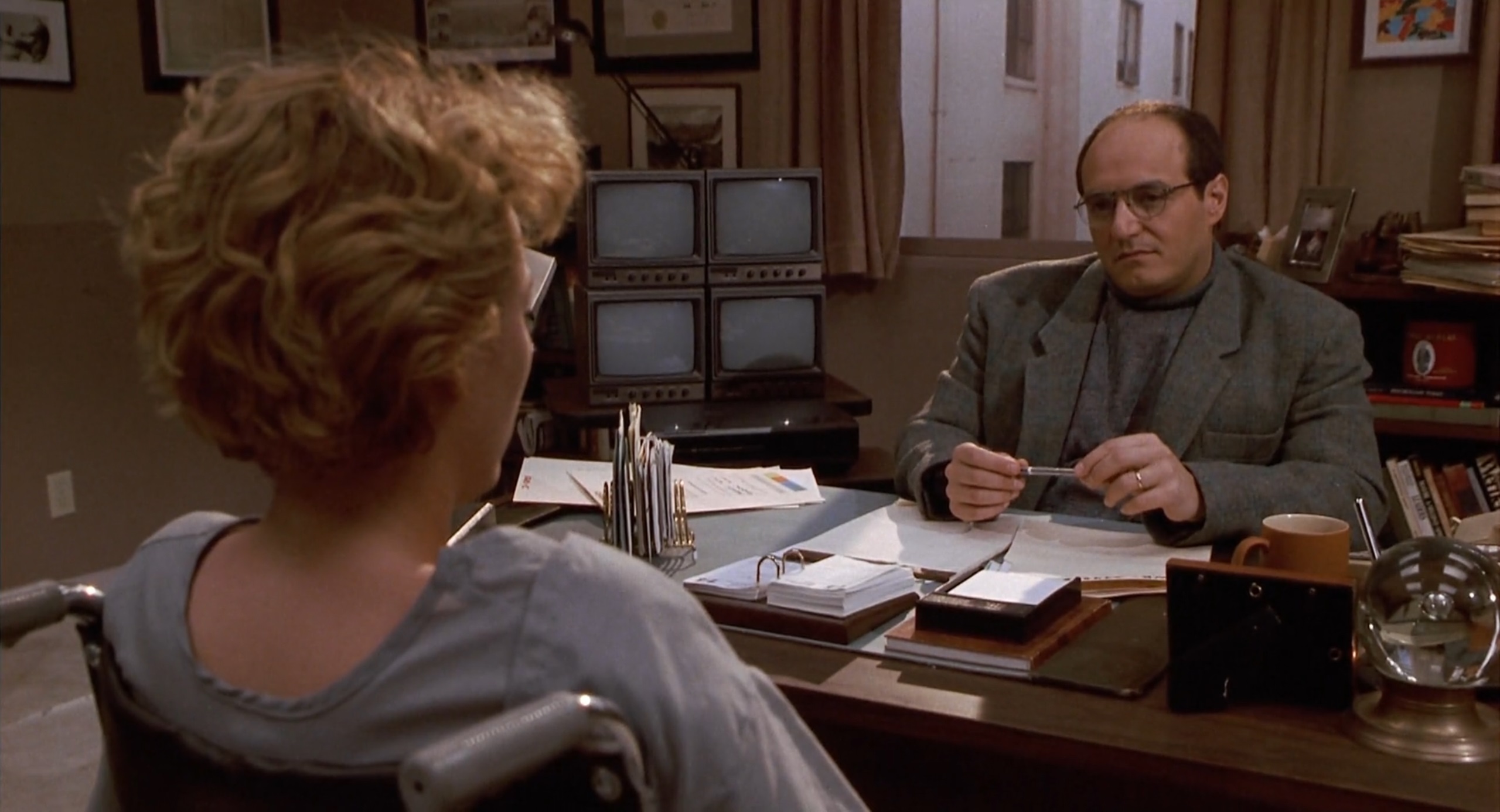 Candyman (1992) 01:07:18
Candyman (1992) 01:07:18
The one unit of action I would argue that ties these shots into a complete scene is Helen summoning Candyman and the immediate response to her “spell”. When Helen is being set free and escaping afterward seem to be separate actions and scenes. The scene at 01:10:00-01:11:02 begins with a straight cut from Dr. Burke (Stanley DeSantis) to Helen in a shallow focus, medium close-up shot. The lighting in this scene has a low-contrast high key top lighting that simulates florescent lighting from the 90’s. All the shots in this scene are still shots except for shot six which pans and zooms. In shot one, Helen says, “I can prove it”, which straight cuts from a subjective medium close-up shot of Helen strapped to her wheelchair, to the same type of shot of Dr. Burke, his disapproving demeanor almost cutting her off just as the shot transition does. He has four small television screens set to his right, along with a stack of papers on the right side of his desk. There is a bookshelf with other folders and books stacked on it in the left background, and certificates of some kind framed on the wall of the background to his right behind the tv screens. The organization of his background gives a validity to his glances and positions, while Helen is portrayed as distraught, without makeup and strapped to a chair in a thin loose medical gown. This contrast again comments and critiques our audacious female protagonist with the male patriarchal establishment of the psychotherapy clinic and police department.
Dr. Burke states more than asks, “How”, already not believing her. We return to Dr Burke’s perspective on Helen in the same close-up from shot one as she hesitates for a moment, tenses her bottom lip and shakes her head slightly saying, “I can call him”. A straight cut into shot four shows Dr. Burke in the same angle as shot two, leaning his head back and looking down his nose at her while fiddling with a pen in his hand. Without speaking, the camera straight cuts back to Helen, she returns her eyes to Dr. Burke and rolls her own head back then glances down. Helen is always having to interrupt her gaze in Candyman. In this instance she looks to her left just before the camera straight cuts to a new angle. The music has been playing low in the background of this scene, the same theme that plays throughout the film when Candyman is going to appear or be spoken of. The theme is a chorus of voices and an eerie sounding melody played on an organ. It begins to rise to a crescendo as she pulls her head back in shot five.
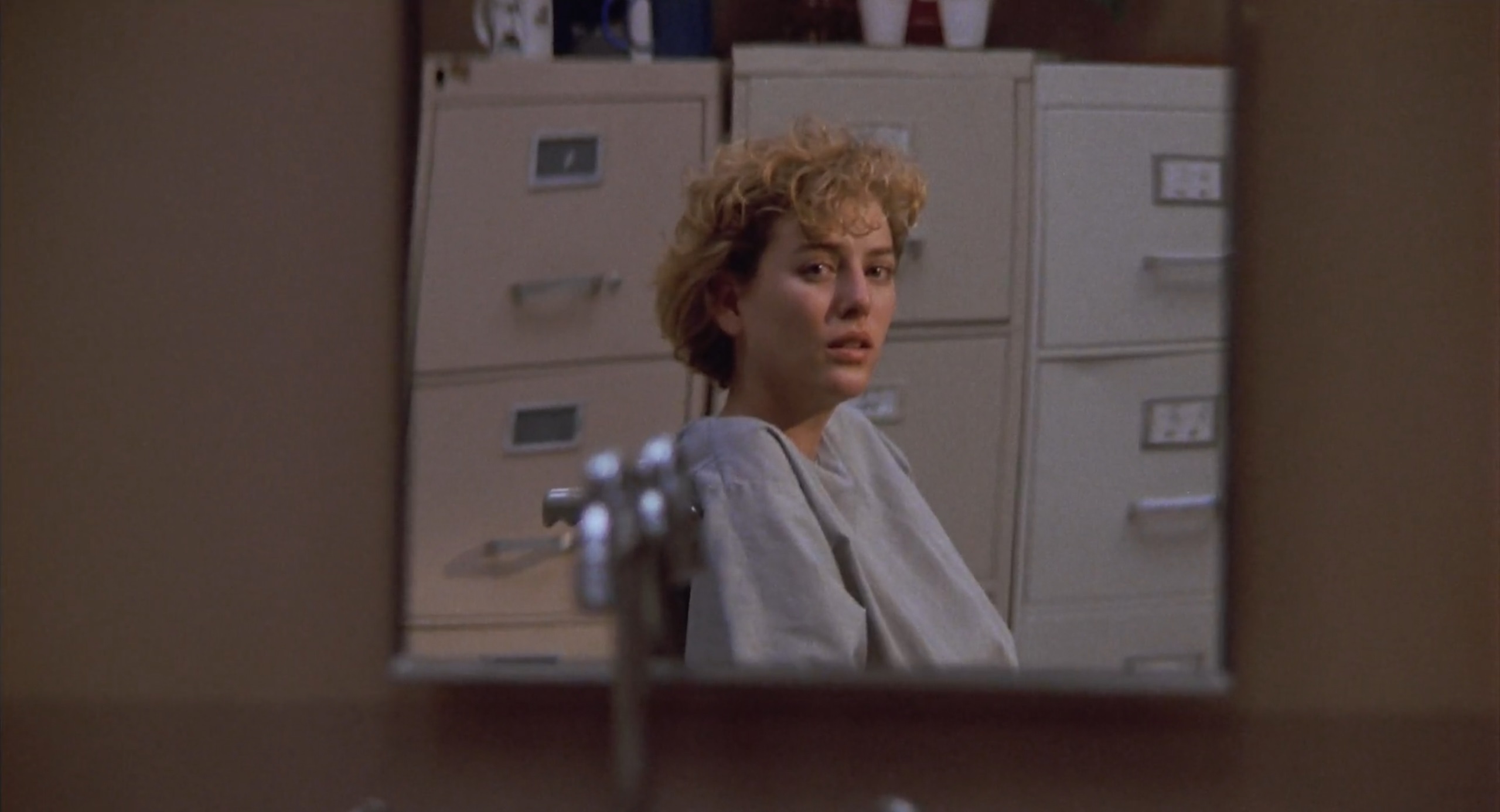 Candyman (1992) 01:10:29
Candyman (1992) 01:10:29
Shot six, the most defining shot of the scene, goes from an objective shot of Helen’s right profile panning into a subjective shot of her looking at her reflection at a mirror attached to a sink in the room. The camera pans and zooms across the room from Helen in a shallow focus to a deep focus of the entire set until it reaches Helen’s gaze in the mirror, transforming to a rack focus of her reflection. While the camera pans, she begins to say Candyman just a bit louder than a whisper, she says the name four times and then goes silent. She closes her eyes, turns her head back to Dr. Burke, and opens them, almost having to look at him for reassurance or to make sure he is watching, and knows he is responsible.
The camera straight cuts back to Dr. Burke in shot seven as he brings his arms together across his desk and leans in, narrowing his own gaze at her. Shot eight returns to a similar position to where the camera left at the end of shot six, but with the sink fixture barely perceptible in the foreground. Helen quickly returns her head and eyes to the mirror in one fluid motion and more confident than the previous four, says Candyman for the fifth time. Tears are almost welled up in her eyes, the camera just slightly bobbing throughout, as she looks forward again in the direction of Dr. Burke, away from the mirror and the camera. The music has reached the climax by shot nine as Dr. Burke continues to play with his pen, now with one end in each of his hands. He rolls his head back while looking at Helen, ever so slightly nods up and down, his entire body language is mocking her. In shot ten Helen, in the same angle as shot one, glances from Burke back to the mirror and back to Burke. Her eyelids are trembling as the music continues to overtake the room. As she holds her gaze to Dr. Burke, she breaks it once again and looks down and to the right, away from the mirror as if to second guess herself and her memories, before finally looking up at Dr. Burke right before the straight cut to shot eleven. In this medium close-up shot of Dr Burke, he has sat forward in his chair and is at full attention, seemingly finally in the conversation, he rolls his eyes and then lets out a grunt before coughing up blood and having his body thrown forward with Candyman emerging behind him. Shot twelve is a straight cut during the altercation to show Helen, who is still strapped to her wheelchair with a horrified, twisted facial expression. She wails out a loud “oh!” at having to witness the execution of Dr. Burke, still bound and not able to escape or help.
According to Williams’ essay, “When the Woman Looks”, when the film forces Helen to witness Dr. Burke’s murder is an example of a narrative and physical punishment in the form of psychological trauma. Similarly, Helen is framed again for Dr. Burke’s murder, another consequence in exchange for her daring to look and speak to the forbidden. This also shows the theme of Candyman openly in its bare portrayal of the persecution the legal system has placed on our female protagonist while at the same time delivering some ‘just deserts’ to Dr. Burke as a representative of this system. By punishing the patriarchy in this way, and later through Helen claiming Trevor as a victim, director Bernard Rose in Candyman paints a deliberate condemnation of the treatment our “societal schema” creates towards women, especially black men and women throughout the film and through deliberate camera focus. The plot in Candyman matches with Carroll’s framework of how a horror narrative should be set up to engage with audiences by placing Helen on a course to investigate Candyman, a monster who not only violates laws and norms but complicates the social strata as well (Carroll). The societal outside forces persecute Helen and endanger her as much as the monster Candyman does. The predecessors of the social norms Candyman’s existence complicates created him by murdering him in his own time, for just having a relationship with a white woman. Candyman is now able to use those same oppressive levers to lead Helen to her own demise, and to his own ends.
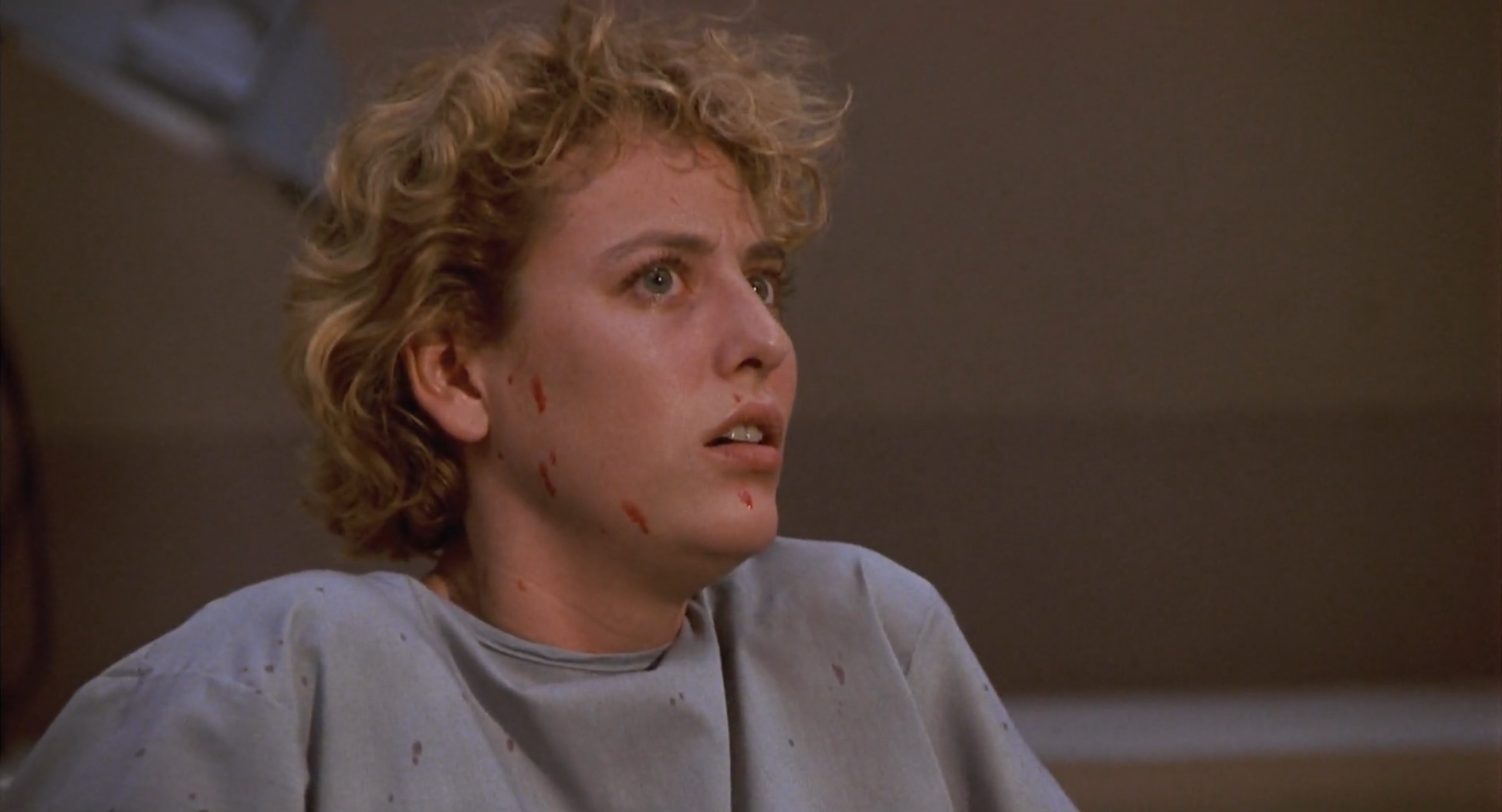 Candyman (1992) 01:11:13
Candyman (1992) 01:11:13
Throughout Linda Williams’ analysis in “When the Woman Looks”, she deconstructs the monsters or villains in horror film as metaphors for how society treats a woman’s true self. She explains that horror “grants” the power of controlling the camera’s perspective only for the subject to be punished. What she “focuses” or “looks” at, is the male characters which betrays, her desires which are thwarted, or the monster themselves harming her physically and/or psychologically (Williams). She inquires further with the way some horror films such as King Kong and Beauty and the Beast create an “affinity” or a relationship between the heroine and the monster, without physical harm coming to her, these films instead highlight the danger women pose to the patriarchal power structure. The monster, in a similar fashion, may highlight the age-old myth of “the other”, immigrants, the poor, or people of color’s supposed threat to the white male power structure. In some horror film therefore, both a female protagonist and metaphorical “other” monster can each represent a specific under-swirling threat to the dominant or established culture or order.
Virginia Madsen’s acting as Helen Lyle in this second scene is excellent in conveying the vulnerability and fear she is experiencing while trying to evaluate the idea that what she has been experiencing, might be a hallucination. The way she speaks in a hoarse whisper, is almost fidgety with her eyes while keeping her facial animations deliberate and unified, are faultless tension builders. Dr. Burke’s performance coincides with Williams’ ideas of a woman’s gaze always being met with punishment, here directly in the narrative by the defense of herself and eyesight into the camera all being met with his disapproving eyes and body language. The lighting in the room remains constant throughout, placing this power dynamic and punishment into a realistic setting, a hospital or office building, somewhere the audience would be familiar with. Candyman appears and delivers traumatic punishment to Helen by forcing her to witness and react to Dr. Burke’s murder, her reaction of twisted horror is supplanted by her being covered again in blood. Similar to her being a prisoner in the psychiatric hospital, she is still strapped to her wheelchair, another symbolic use of set that can be compared to the mobility of woman in society having to be pushed forward by officials or “men”. Helen’s inability to maintain constant eye contact with Dr. Burke is a valuable aspect of the mise-en-scene that reinforces the pressure being exerted not only on Helen by the law, but by woman in general in the face of the patriarchy.
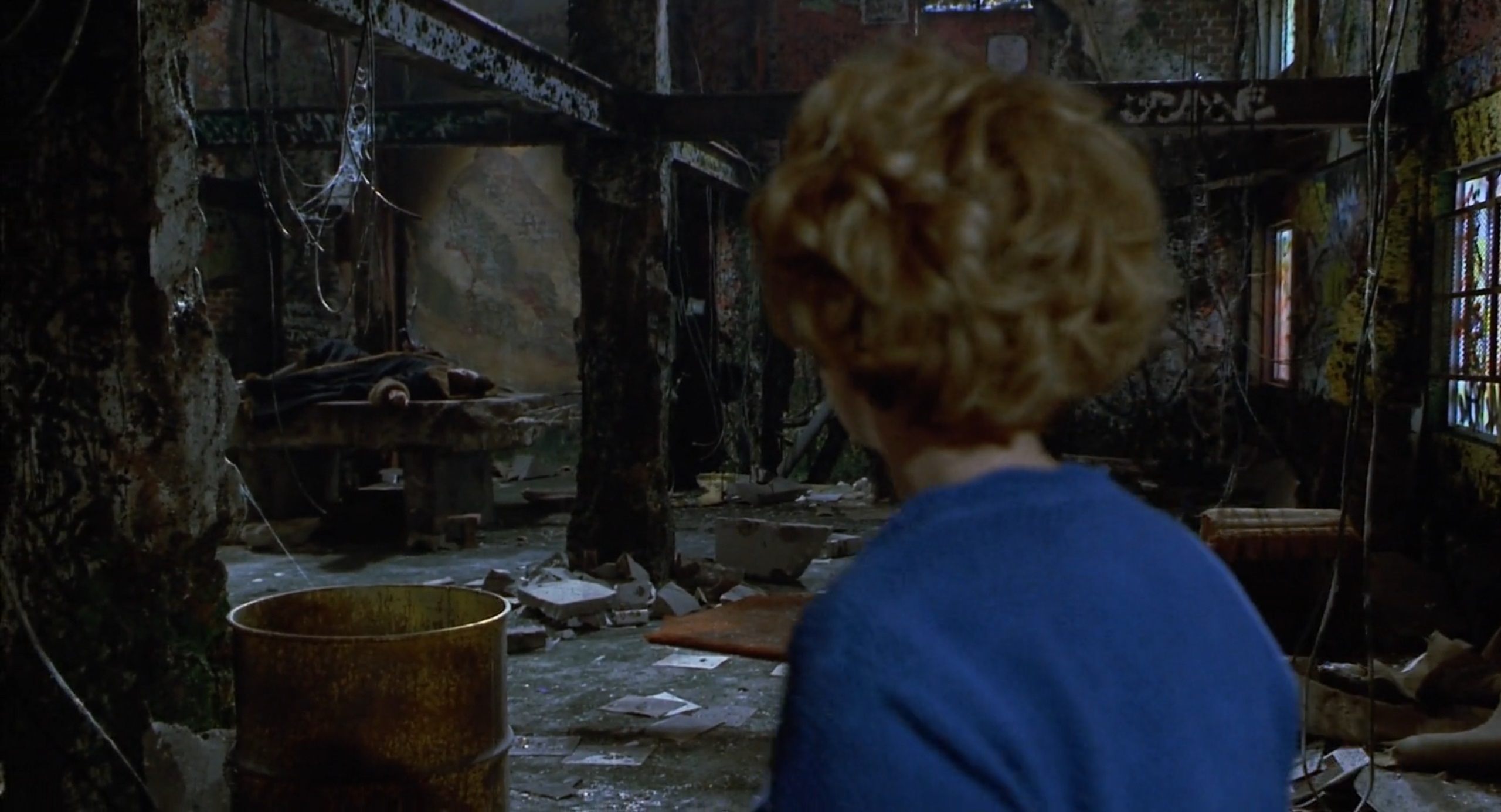 Candyman (1992) 01:20:40
Candyman (1992) 01:20:40
The camera remains at eye level with Helen in each shot and slightly at chin level to Dr. Burke, except for shot 6 which travels across the room to meet Helen’s gaze into the mirror while she recites Candyman five times. The significance with all the other shots remaining a static structure resembling society, and of the only moving shot in this scene being the woman’s look which results in Helen being shunned by the therapist and then traumatized by the monster, is a faithful example of Linda Williams’ principals of horror film regarding woman and society’s reaction to their autonomy. I think Williams would find a lot of her ideals about horror replicated in Candyman, especially this example of Helen being judged by the therapist as a psychotic, lying criminal. Upon Dr. Burke’s murder in shot eleven by Candyman, the camera still remains static and does not move for his murder. Special attention and movement are kept by the camera only for when Helen is trying to prove her innocence desperately in the eyes of the law. This challenge and deliberate gaze against the law’s authority and control over Helen is then rewarded with “a particularly interesting example of this punishment in the woman’s terrified look at the horrible body of the monster”; when Helen challenges society she is punished with a monster who is also ostracized by, yet representing society (Williams).
Although my research of Candyman underscores Helen’s navigation through a community that excludes her travel and disbelieves her, I think the film does go a long way in exploring that persecution and empowering Helen to stand in its face. Merely representing a social construct in a film does not mean the film condones such a construct, but rather sometimes chooses to display it as a critique. In Briony Kidd’s article “Scream Time: Women Take Power over Horror”, Kidd discusses a recent trend of female filmmakers in the horror genre. Although Candyman was directed by Bernard Rose, a man, the article discusses female directors focusing on feminine or more serious issues with their horror films. I think this lines up well with my analysis of Candyman. Kidd writes, “But shouldn’t any film, horror or not, be exploring ‘serious’ issues?”. She goes on to note how female directors with this prerogative or not sometimes face harsher critique for their films, while offering the counter view of Heidi Honeycutt that “female-response horror”, horror films made by and(or) about feminine issues, present a unique and valuable perspective (Kidd). “These female horror outings are changing the perception of horror by telling female stories and promoting tough roles for women. No longer is the Final Girl a virginal victim that fights back, but now made over to become a strong protagonist that has lived life experience and enjoys it!” (Kidd). Although Candyman was shot twenty years before this modern film movement of female-response horror and is directed by Rose, the film does allow Helen to navigate and push the boundaries of her acceptable action in the face of gang violence and the male oriented legal system restraining her. In the end Helen is able to save the child and become a hero usually reserved for the male protagonist, instead of the typical victim in horror films feminine roles can usually suffer. Candyman also explores the complicated relationship white women share with the black community. A white woman has indirectly caused Candyman’s death in the legend, while Helen trespasses into their private spaces, ultimately able to save one of the community’s children with her determination to help them and solve her mystery.
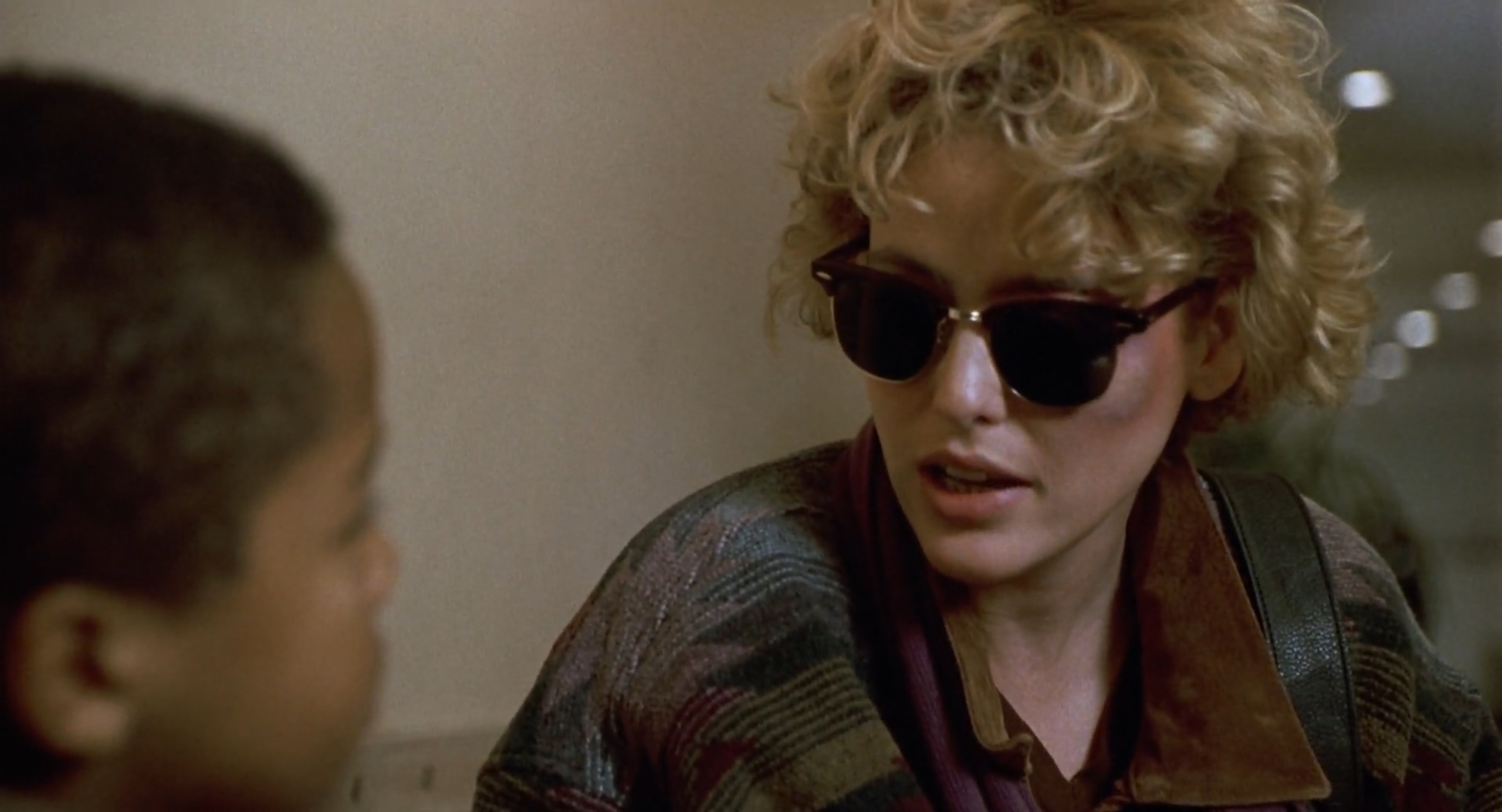 Candyman (1992) 00:41:40
Candyman (1992) 00:41:40
To me the themes focused on, and the way the narrative empowers Helen, makes Candyman come off as a feminist film. It was before its time so Candyman has some lacking qualities in the feminist movement such as how it disregards Bernadette and does spectacularize the female body by covering Helen in blood and making her strip naked in the jail, these can also be seen as representing the status quo in society at its time, and even translates now. By showing them in such adverse situations, these scenes can be interpreted as showing the subjugation and mistreatment of the female figure specifically to criticize these social norms Carroll refers to in her essay, “Horror problematizes the social strata” (Carroll). In Katherine Farrimond’s essay “‘Being a Horror Fan and Being a Feminist Are Often a Conflicting Business’: Feminist Horror, the Opinion Economy and Teeth’s Gendered Audiences.”, Farrimond analyzes over 70 different reviews for the horror film Teeth, which like Candyman, features a female protagonist but is much more well known for being a “feminist film”. Teeth is a film about a woman who has private parts that are fanged, so she can rip off invading forces with her genitals, a rather forward way to empower women. Farrimond observes the current culture of reviewing past films, categorizing them, and the climate of strong opinions from critics throughout the essay, and makes some interesting comments about feminism and horror film. Farrimond’s essay states eloquently,
While horror is frequently positioned as a bad object for women and for feminism, this relationship is reoriented when horror itself is seen as participating in feminist debates. Those films labelled ‘feminist horror’ are thus positioned as a response to the given of women’s natural antipathy to horror and, in the process, the terms of horror as bad object are redrawn. In the process of making horror feminist, feminist horror potentially becomes a bad object for men, particularly when the making of feminist horror is understood as reversing the gendered power dynamics supposedly at work in horror more generally. (Farrimond)
Horror films generally use the female body as merely a spectacle for the male gaze of the camera while subjecting them to torture or murder or worse, such as the opening scenes to most Jason or Freddy films in the 90’s. This is what Farrimond describes as being a bad object for women, it degrades and devalues them, while “feminist horror” films instead reverse the roles, critiquing the male character (or patriarchy), and devalues their opinion or power through the narrative. Candyman, albeit crudely at times does reverse this role, while temporarily allowing male figures such as Helen’s husband Trevor or Dr. Burke power over our female protagonist, they are eventually undone by her determination and empowerment throughout the film.
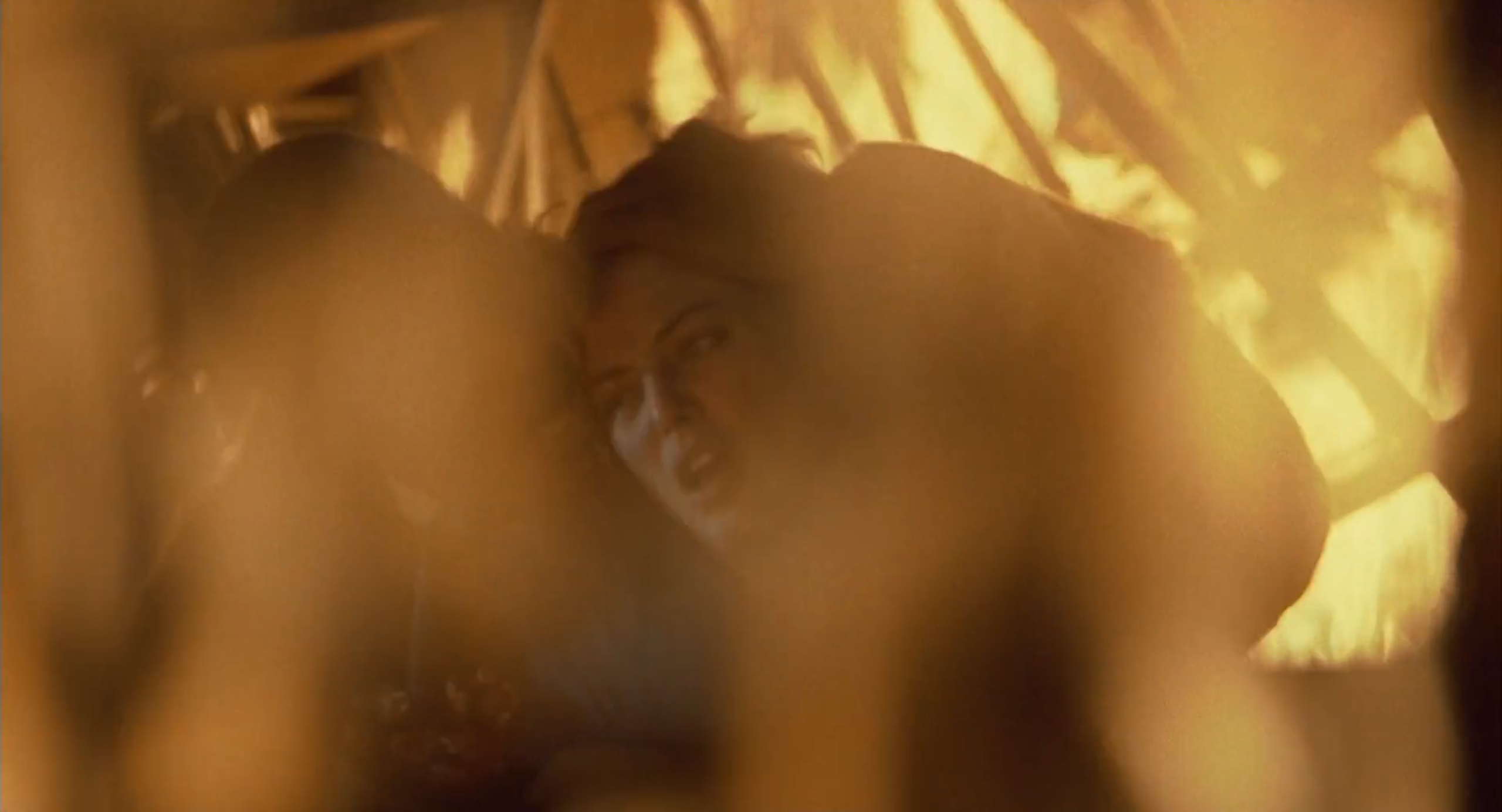 Candyman (1992) 01:28:22
Candyman (1992) 01:28:22
The "monster" in Candyman takes the shape of just a black man, except with a hook. Without the hook, the black man still represents like Helen, an imaginary threat to the white dominated patriarchy in the United States. We look at Helen who glances away, momentarily accepting the shame being imposed on her by the male dominated space she lives in. The woman's look, and Helen’s empowerment is punished immediately by the therapist’s judgment and her husband’s betrayal to the legal system. Then Helen is punished again narratively from the monster, arriving and murdering the therapist, and by her community, being attacked by the gang members and then detained by the police department. She is tied to the chair, and is forced to watch the execution, and is even sprayed with blood, mirroring the degradation women and their truth suffer in the face of that same legal system claiming to serve them. Candyman both punishes and frees Helen. The act of Helen in speaking to defend herself and looking into what is forbidden, has the consequence of her being tormented and falsely accused, her body being manipulated and displaced. Candyman’s plot follows Carroll’s classic example of a horror plot in discovering, following, and confronting the monster Candyman, his legend, and their significance. Helen is the woman who looks, while physically and metaphorically restrained, speaks the forbidden to power, the monster, and herself. Helen in return is granted further exploitation yet gains some inner autonomy in her determination and actions. Candyman has the qualities of an early feminist horror film.
Candyman. By Clive Barker. Directed by Bernard Rose, performances by Virginia Madsen, Tony Todd, Kasi Lemmons, and Xander Berkeley. Propaganda Films, 1992.
Carroll, Noel. “Why Horror?” Mark Jancovich. Horror: The Film Reader. London: Routledge, 2002, pp. 33-45. ISBN 9780415235624
Farrimond, Katherine. “‘Being a Horror Fan and Being a Feminist Are Often a Conflicting Business’: Feminist Horror, the Opinion Economy and Teeth’s Gendered Audiences.” Horror Studies, vol. 11, no. 2, Oct. 2020. 149–168. EBSCOhost, https://doi.org/10.1386/host_00016_1. Accessed 15 December 2020.
Kidd, Briony. “Scream Time: Women Take Power over Horror.” Metro, no. 173, Winter 2012. 102–105. EBSCOhost, https://research.ebsco.com/linkprocessor/plink?id=258e7fb2-f5dc-349a-81a9-1eaebc6f0dce. Accessed 15 December 2020.
Williams, Linda. "When the Woman Looks." Mary Ann Doane, Patricia Mellencamp, and Linda Williams. Re-vision: essays in feminist film cricism, vol. 3, The American Film Institute monograph series. Los Angeles: University Publications of America, 1984, pp. 83-99. ISBN 9780890935859.
Chandler Murray
e:Murrayc15@gator.uhd.edu